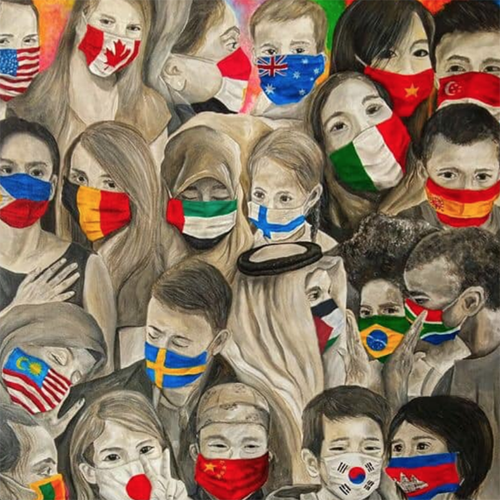Introduction
The scourge of child trafficking and systemic corruption, as highlighted by Whitney Webb’s One Nation Under Blackmail, reveals a chilling reality: powerful individuals are allegedly groomed into compromising acts—often involving minors—to enable blackmail and control their decisions. This article proposes a bold solution to dismantle these networks, focusing on the Trump administration’s current efforts to combat child trafficking and a visionary plan to expose the puppet masters behind global corruption. By bringing evidence before the public and legal tribunals, detaining key operatives and securing their testimonies under oath, this strategy aims to unmask handlers, disrupt blackmail schemes, and restore justice, independence and peace.
The Problem: Child Trafficking and Elite Blackmail
Child trafficking networks, such as the decentralized 764 group, exploit vulnerable minors through online grooming and sextortion, producing illicit content for profit or perverse gratification. Operating since the early 2020s on platforms like Discord and Telegram, 764 targets children aged 10–17, manipulating them into self-harm and illegal acts. Beyond these immediate crimes, One Nation Under Blackmail alleges a broader system where elites are coerced into unspeakable acts to ensure compliance, perpetuating mass deception, warmongering and covert operations like eugenics or slow-kill programs.
Recent claims by HHS Secretary Robert F. Kennedy Jr. and President Donald Trump amplify the urgency, alleging that over 300,000 unaccompanied migrant children “disappeared” under the Biden administration’s HHS, potentially into trafficking networks. While a 2024 DHS Inspector General report notes administrative failures—323,000 minors missing court notices or hearings—no evidence confirms systemic trafficking or HHS complicity. These findings underscore the need for a comprehensive strategy to address both immediate trafficking and the alleged blackmail networks sustaining global corruption.
The Solution: Public Exposure and Legal Accountability
The most effective way to dismantle this corrupt system is to expose its operatives—referred to as “assets”—and their handlers through a coordinated, large-scale effort. These assets, groomed into power and coerced into compromising acts, hold the key to revealing the architects of global control. The proposed plan involves:
- Identification and Detention:
- Leverage intelligence and law enforcement to identify individuals within government, business and elite circles suspected of involvement in trafficking or blackmail networks.
- Conduct a synchronized operation to detain these assets, ensuring minimal disruption to public safety while maximizing impact on the corrupt system.
- Testimony Under Oath:
- Offer detained assets the opportunity to testify under oath about their actions, from initial grooming to their rise in power. Testimonies would detail conditions of duress, identifying handlers and exposing schemes like mass deception, warmongering, or eugenics programs.
- Provide legal protections, such as reduced sentences or immunity, to incentivize truthful accounts while ensuring accountability for crimes.
- Public and Legal Tribunals:
- Present evidence and testimonies in transparent public tribunals, broadcast to maximize awareness and prevent cover-ups. These tribunals would combine judicial rigor with public engagement, akin to truth and reconciliation commissions.
- Pursue prosecutions for treason, crimes against humanity and related offenses, targeting both assets and their handlers.
- Disrupting the Network:
- By removing assets from positions of influence, the puppet masters lose their intermediaries, forcing them out of the shadows to face justice.
- Use testimonies to map and dismantle trafficking and blackmail networks, targeting financial flows, digital platforms and operational hubs.
- Redemption and Restoration:
- Offer assets a path to redemption through cooperation, allowing them to reclaim dignity by helping dismantle the corrupt world order.
- Foster public healing by prioritizing victim support, including resources for trafficking survivors and systemic reforms to prevent future exploitation.
Current Administration Efforts: A Foundation
The Trump administration’s actions provide a starting point for this ambitious plan, particularly in combating child trafficking:
- Crackdown on 764: In April 2025, the FBI dismantled key leaders of the 764 network, disrupting its online exploitation of minors. Public warnings and calls for platform accountability reflect a proactive stance against digital trafficking.
- HHS Reforms: RFK Jr. and border czar Tom Homan are investigating the 323,000 unaccompanied minors cited in the DHS report, revising HHS’s Office of Refugee Resettlement protocols to enhance sponsor vetting and tracking. While claims of HHS’s role in trafficking lack evidence, the focus on locating vulnerable children aligns with broader anti-trafficking goals.
- Border Security: Trump’s policies aim to reduce the influx of unaccompanied minors, addressing vulnerabilities exploited by cartels and traffickers.
- Anti-Trafficking Rhetoric: The administration’s emphasis on trafficking as a national crisis raises awareness, though politicized claims risk undermining bipartisan support.
These efforts, while significant, focus primarily on immediate trafficking rather than the systemic blackmail alleged in One Nation Under Blackmail. The proposed plan builds on this foundation, extending the administration’s momentum into a transformative strategy.
Kickstarting the Process
Implementing this plan requires careful coordination and public support. Key steps include:
- Building a Task Force:
- Establish a multi-agency task force, including the FBI, DOJ and international partners, to identify and detain assets. Incorporate whistleblower protections to encourage insiders to come forward.
- Engage independent investigators to ensure impartiality and counter accusations of political bias.
- Securing Public Backing:
- Launch a public awareness campaign, leveraging platforms like X to share evidence of trafficking and blackmail without compromising investigations. Highlight cases like Jeffrey Epstein’s network to underscore the stakes.
- Partner with advocacy groups and trafficking survivors to humanize the issue and build grassroots support.
- Legal Framework:
- Draft legislation to authorize public tribunals and protect testifying assets, balancing accountability with incentives for cooperation.
- Collaborate with international bodies like Interpol to address transnational networks.
- Technological Tools:
- Develop advanced digital forensics to track trafficking and blackmail operations on encrypted platforms, building on efforts against groups like 764.
- Invest in AI-driven analysis to map connections between assets and handlers, prioritizing high-impact targets.
- Pilot Phase:
- Begin with a high-profile case, such as a known trafficking network or Epstein-linked figure, to test the detention-and-testimony model. Success here could build momentum for broader implementation.
Challenges and Considerations
- Evidence Gaps: While cases like Epstein’s provide precedent, broader claims of systemic blackmail lack comprehensive documentation. Testimonies must be rigorously verified to avoid misinformation.
- Political Polarization: The administration’s partisan framing of trafficking risks alienating allies. The plan must emphasize bipartisan justice to maintain credibility.
- Privacy and Ethics: Detaining assets and publicizing testimonies raises privacy concerns. Safeguards, such as anonymized evidence where necessary, are critical.
- Global Scope: Blackmail networks operate transnationally, requiring cooperation with skeptical or complicit governments.
- Redemption Risks: Offering assets leniency could spark public backlash, necessitating transparent communication about justice and victim priorities.
Comparison to Trump’s First Term
During Trump’s first term (2017–2021), anti-trafficking efforts included Executive Order 13903 (2020) and legislation like the Allow States and Victims to Fight Online Sex Trafficking Act (2017). However, prosecutions of child sex trafficking declined (124 cases in 2017 to 73 in 2019) and the family separation policy faced criticism for increasing children’s vulnerability. The second term’s focus on 764, HHS reforms and the 323,000 minors signals greater urgency, but it lacks a direct response to elite blackmail. The proposed plan bridges this gap, aligning with the administration’s rhetoric while addressing systemic corruption head-on.
Outcomes and Impact
- Immediate Impact: Disrupting trafficking networks like 764 and locating vulnerable children would save lives and deter future exploitation.
- Systemic Change: Exposing handlers through asset testimonies could dismantle blackmail networks, weakening the corrupt world order described in One Nation Under Blackmail.
- Global Freedom: By forcing puppet masters into accountability, the plan could reduce warmongering, deception and eugenics-like schemes, fostering lasting peace.
- Redemption and Healing: Assets who cooperate reclaim purpose, while victims gain justice and support, paving the way for societal restoration.
Conclusion
The Trump administration’s efforts against child trafficking—targeting 764, reforming HHS and prioritizing vulnerable minors—lay a foundation for combating systemic corruption. However, the allegations in One Nation Under Blackmail demand a bolder approach. By detaining assets, securing their testimonies and presenting evidence in public tribunals, this plan unmasks the handlers orchestrating trafficking and blackmail, dismantling their grip on power. Kickstarting this process requires a task force, public support and a legal framework, with a pilot case to build momentum. Despite challenges, the potential to restore independence, deliver justice, and achieve global peace makes this strategy a moral and practical imperative.
Call to Action
- Demand Transparency: Urge leaders to investigate elite blackmail networks and share findings publicly.
- Support Victims: Advocate for resources and protections for trafficking survivors.
- Engage Locally: Educate communities about online exploitation and systemic corruption, building grassroots momentum for change.
- Hold Leaders Accountable: Press the administration to act on its anti-trafficking promises and expand efforts to address blackmail.
(image from Black Mirror episode: “Shut Up and Dance” a teen compromised in a sextortion scheme.)
![]()





